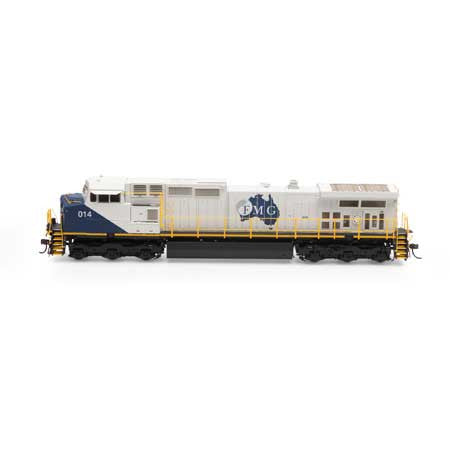The Athearn ATHG31636 G2 GE Dash 9-44CW is a high - quality HO scale model. It represents the FMG Fortescue Metals Group locomotive #014 and comes equipped with DCC and Sound Tsunami2. FMG - specific features include spare knuckles on the rear pilot, unique handrails with extra railing, front - only ditch lights on the anticlimber, and a Nathan K5LA horn. These locomotives are part of a late - production MRL order, with 6 - step walkways and standard GPS dome antennas on the cab roof. The railway is used for extremely heavy iron - ore trains. The Dash 9 series locomotive offers fully - assembled and ready - to - run operation. It has DCC - ready features with Quick Plug™ technology and a 21 - pin NEM connector. The model is accurately scaled from prototype resources, with detailed paint schemes. It has various fine - scale details like coupler cut levers, flexible hoses, see - through cab windows, and a full cab interior. The Genesis 2.0 version brings additional features such as etched walkway steps, illuminated number boards, and ground and walkway lights. Sound - equipped models have an onboard DCC decoder with SoundTraxx Tsunami2 sound, dual cube speakers, and work in both DC and DCC. The prototype, built by GE from 1993 - 2004, was a leading North American mainline freight locomotive. This Athearn model inherits its excellence with reliable drive and LED lighting. Specifications include DCC and Sound Tsunami2, a GE prototype manufacturer, 6 axles, LED lighting, a minimum age recommendation of 14 years, and no assembly required.

Using this Athearn locomotive is easy. Since it's fully - assembled, you can just take it out of the box and place it on the track. If you're using a DCC system, connect it to your controller via the 21 - pin NEM connector. For DC operation, it's also straightforward. The sound function adds a lot of realism. You can hear engine, horn, and bell sounds in DC, and enjoy full DCC functions in DCC mode. When programming a multiple - unit lashup, you can set the lead unit to control horn, bell, and lights. Regarding maintenance, keep it clean. You can use a soft brush to remove dust from the body, wheels, and other parts. Avoid using harsh chemicals as they may damage the paint or plastic parts. Store the locomotive in its original packaging to protect it from scratches and impacts. Also, make sure to keep it away from extreme temperatures and humidity to ensure long - term performance.









